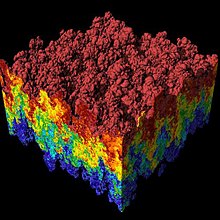Lennard-Jones potential

| Computational physics |
|---|
 |
The Lennard-Jones potential (also referred to as the L-J potential, 6-12 potential, or 12-6 potential) is a mathematically simple model that approximates the interaction between a pair of neutral atoms or molecules. A form of the potential was first proposed in 1924 by John Lennard-Jones.[1] The most common expressions of the L-J potential are
where ε is the depth of the potential well, σ is the finite distance at which the inter-particle potential is zero, r is the distance between the particles, and is the distance at which the potential reaches its minimum. At rm, the potential function has the value −ε. The distances are related as rm = 21/6σ. These parameters can be fitted to reproduce experimental data or accurate quantum chemistry calculations. Due to its computational simplicity, the Lennard-Jones potential is used extensively in computer simulations even though more accurate potentials exist.
Explanation
The r−12 term, which is the repulsive term, describes Pauli repulsion at short ranges due to overlapping electron orbitals and the r−6 term, which is the attractive long-range term, describes attraction at long ranges (van der Waals force, or dispersion force). Whereas the functional form of the attractive term has a clear physical justification, the repulsive term has no theoretical justification. It is used because it approximates the Pauli repulsion well, and is more convenient due to the relative computational efficiency of calculating r12 as the square of r6.
The Lennard-Jones (12,6) potential can be further approximated by the (exp-6) potential later proposed by R. A. Buckingham, in which the repulsive part is exponential:[2]
The L-J potential is a relatively good approximation and due to its simplicity is often used to describe the properties of gases, and to model dispersion and overlap interactions in molecular models. It is particularly accurate for noble gas atoms and is a good approximation at long and short distances for neutral atoms and molecules.
The lowest energy arrangement of an infinite number of atoms described by a Lennard-Jones potential is a hexagonal close-packing. On raising temperature, the lowest free energy arrangement becomes cubic close packing and then liquid. Under pressure the lowest energy structure switches between cubic and hexagonal close packing.[3] Real materials include BCC structures as well.[4]
Other more recent methods, such as the Stockmayer potential, describe the interaction of molecules more accurately. Quantum chemistry methods, Møller–Plesset perturbation theory, coupled cluster method or full configuration interaction can give extremely accurate results, but require large computational cost.
Alternative expressions
There are many different ways of formulating the Lennard-Jones potential The following are some common forms.
AB form
This form is a simplified formulation that is used by some simulation software packages:
where, and . Conversely, and . This is the form in which Lennard-Jones wrote the 12-6 potential.[5]
Truncated Lennard-Jones potential
To save computational time, the Lennard-Jones potential is often truncated at a cut-off distance of rc = 2.5σ, where
(1)
i.e., at rc = 2.5σ, the Lennard-Jones potential, VLJ, is about 1/60th of its minimum value, ε (the depth of the potential well). Beyond , the truncated potential is set to zero.
To avoid a jump discontinuity at , the LJ potential must be shifted upward a little so that the truncated potential would be zero exactly at the cut-off distance, .
For clarity, let denote the LJ potential as defined above, i.e.,
(2)
Then the truncated Lennard-Jones potential is defined as follows[6]
(3)
It can be easily verified that VLJtrunc(rc) = 0, thus eliminating the jump discontinuity at r = rc. Although the value of the (unshifted) Lennard Jones potential at r = rc = 2.5σ is rather small, the effect of the truncation can be significant, for instance on the gas–liquid critical point.[7] Fortunately, the potential energy can be corrected for this effect in a mean field manner by adding so-called tail corrections.[8]
See also
- Molecular mechanics
- Embedded atom model
- Morse potential
- Force field (chemistry)
- Force field implementation
- Lennard-Jones model on SklogWiki.
References
- ^ Lennard-Jones, J. E. (1924), "On the Determination of Molecular Fields", Proc. R. Soc. Lond. A, 106 (738): 463–477, Bibcode:1924RSPSA.106..463J, doi:10.1098/rspa.1924.0082.
- ^ Peter Atkins and Julio de Paula, "Atkins' Physical Chemistry" (8th edn, W. H. Freeman), p.637
- ^ Barron, T. H. K.; Domb, C. (1955), "On the Cubic and Hexagonal Close-Packed Lattices", Proceedings of the Royal Society of London. Series A, Mathematical and Physical Sciences, 227 (1171): 447–465, Bibcode:1955RSPSA.227..447B, doi:10.1098/rspa.1955.0023.
- ^ Calculation of the Lennard-Jones n–m potential energy parameters for metals. Shu Zhen,G. J. Davies. physica status solidi (a)Volume 78, Issue 2, pages 595–605, 16 August 1983
- ^ Attention: This template ({{cite doi}}) is deprecated. To cite the publication identified by doi:10.1088/0959-5309/43/5/301, please use {{cite journal}} (if it was published in a bona fide academic journal, otherwise {{cite report}} with
|doi=10.1088/0959-5309/43/5/301instead. - ^ softmatter:Lennard-Jones Potential, Soft matter, Materials Digital Library Pathway
- ^ Smit, B. (1992), "Phase diagrams of Lennard-Jones fluids", Journal of Chemical Physics, 96 (11): 8639, Bibcode:1992JChPh..96.8639S, doi:10.1063/1.462271.
- ^ Frenkel, D.; Smit, B. (2002), Understanding Molecular Simulation (Second ed.), San Diego: Academic Press, ISBN 0-12-267351-4
{{citation}}: Unknown parameter|lastauthoramp=ignored (|name-list-style=suggested) (help).

![{\displaystyle {\begin{alignedat}{3}V_{LJ}&=4\varepsilon &\left[\left({\frac {\sigma }{r}}\right)^{12}-\left({\frac {\sigma }{r}}\right)^{6}\right]\\&=\varepsilon &\left[\left({\frac {r_{m}}{r}}\right)^{12}-2\left({\frac {r_{m}}{r}}\right)^{6}\right]\end{alignedat}}}](https://wikimedia.org/api/rest_v1/media/math/render/svg/66a7d25a03248635d55cb8f5e4c0d33c30a8b01d)

![{\displaystyle V_{B}=\gamma \left[e^{-r/r_{0}}-\left({\frac {r_{0}}{r}}\right)^{6}\right].}](https://wikimedia.org/api/rest_v1/media/math/render/svg/928720419138930834b055d422adaaac2e8fbaf3)



![{\displaystyle \sigma ={\sqrt[{6}]{\frac {A}{B}}}}](https://wikimedia.org/api/rest_v1/media/math/render/svg/5c6b59b78a7e87b148cd7731a87362db88f22715)

![{\displaystyle \displaystyle V_{LJ}(r_{c})=V_{LJ}(2.5\sigma )=4\varepsilon \left[\left({\frac {\sigma }{2.5\sigma }}\right)^{12}-\left({\frac {\sigma }{2.5\sigma }}\right)^{6}\right]\approx -0.0163\varepsilon }](https://wikimedia.org/api/rest_v1/media/math/render/svg/3479a6fcb7d6fe92e8bb64add79a6338e69899a6)


![{\displaystyle \displaystyle V_{LJ}(r)=4\varepsilon \left[\left({\frac {\sigma }{r}}\right)^{12}-\left({\frac {\sigma }{r}}\right)^{6}\right].}](https://wikimedia.org/api/rest_v1/media/math/render/svg/feee79bb20a4fffcc1d871a44c83d78138804687)

